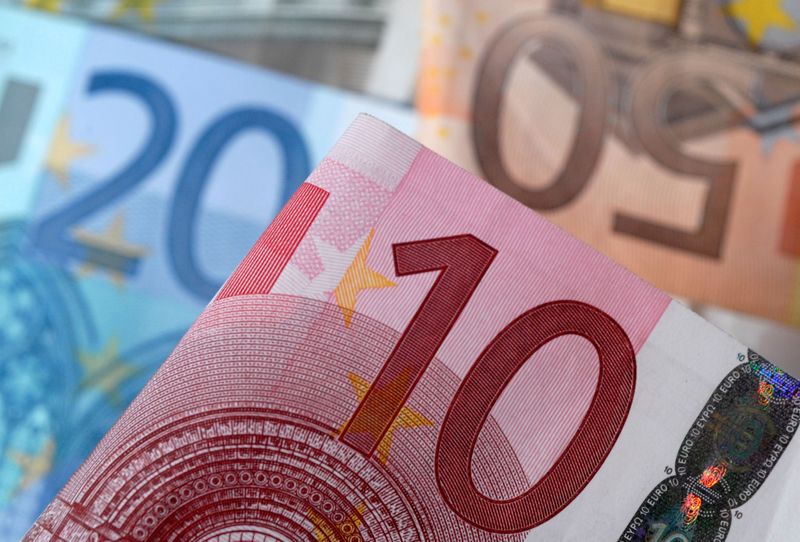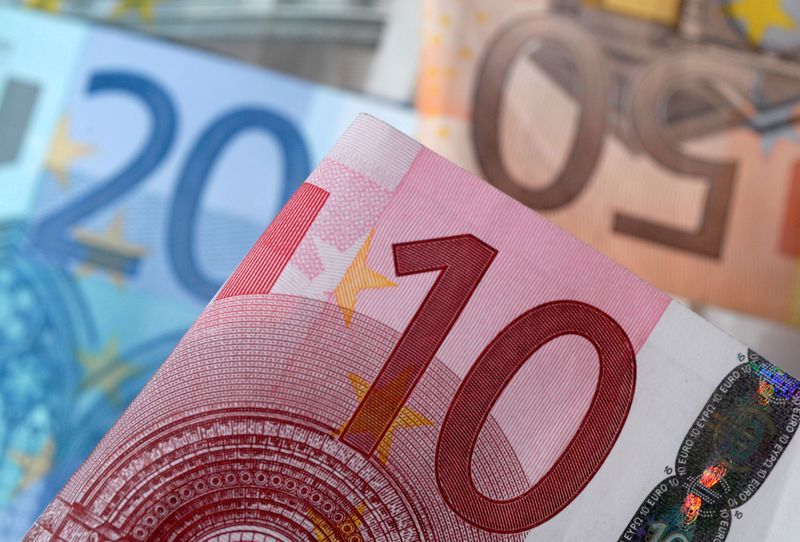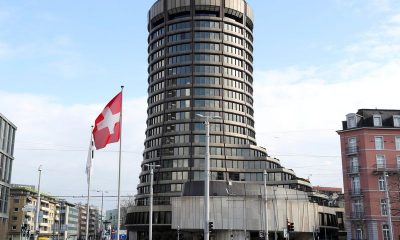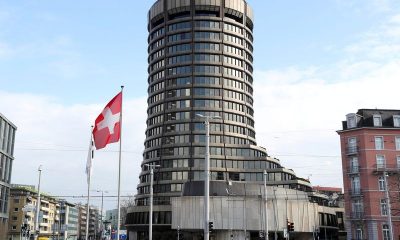Economy
German 2-year bond yield hits 15-year high as traders eye more hikes


© Reuters. FILE PHOTO: A picture illustration of euro banknotes, April 25, 2014. REUTERS/Dado Ruvic/File Photo
By Harry Robertson and Alun John
LONDON (Reuters) -Germany’s two-year bond yield jumped to its highest level in 15 years on Thursday, rising back above the peak it hit in March before jitters in the banking system rocked global markets.
The new milestone was reached during a sharp sell-off in bonds in the euro zone, the United States and Britain, as investors bet central banks would hike interest rates even further than previously expected. Yields move inversely to prices.
Germany’s two-year yield, which is highly sensitive to interest-rate expectations, rose to 3.393%, the highest since autumn 2008. It was last up 8 basis points (bps) at 3.366%.
Global yields were already higher on the day, and rose further after data showed that U.S. private payrolls increased much more than expected in June. Separate data showed that U.S. job openings dropped in May, but remained elevated.
Market analysts and traders said the minutes from the U.S. Federal Reserve’s latest meeting, released on Wednesday, were likely another factor boosting yields on Thursday.
The minutes showed the bulk of policymakers expected they would need to tighten policy further, though they held interest rates at that meeting.
Giles Gale, head of European rates strategy at NatWest Markets, said investors were coming to terms with the idea that central bankers are going to keep rates “higher for longer”.
“That central banks are going to break something and they’ll be cutting rates soon, that’s a story that just isn’t tracking,” he said.
“It’s been a week where frankly it’s all been about fixed income weakness,” he said. “There just doesn’t seem to be the enthusiasm for it.”
The German 10-year bond yield, the benchmark for the euro zone, was last up 15 bps at 2.627% and was on track for its biggest daily increase since March 21.
Germany’s two-year yield has been grinding higher in recent weeks as European Central Bank policymakers have stressed that interest rates are likely to rise further from the current 3.5% as underlying price pressures remain strong.
The yield reached a peak of 3.385% in March before tumbling as a crisis hit mid-sized U.S. banks and Credit Suisse, leading to the latter’s takeover by rival UBS.
Italy’s 10-year yield was 19 bps higher at 4.36%. That caused the gap between Italian and German 10-year yields to widen slightly to 172 bps.
“Markets are saying that inflation is too high, and growth is still too strong, and we need more rate hikes,” said Mike Riddell, senior portfolio manager at Allianz (ETR:) Global Investors.
“Central banks seem to be encouraging markets to believe this too, suggesting more hikes are ahead.”
The U.S. private payrolls data came ahead of the closely watched official employment report on Friday.
Economists stressed that the private payrolls data is not necessarily a good guide to the official report, but markets nonetheless reacted strongly, betting that a strong labour market will likely push the Fed to hike rates again this month.
Traders who bet on the path of interest rates expect the ECB to raise borrowing costs to 4% by December, according to pricing in derivatives markets on Thursday.
Economy
Russian central bank says it needs months to make sure CPI falling before rate cuts -RBC


© Reuters. Russian Central Bank Governor Elvira Nabiullina attends a news conference in Moscow, Russia June 14, 2019. REUTERS/Shamil Zhumatov/File Photo
MOSCOW (Reuters) – Russia’s central bank will need two to three months to make sure that inflation is steadily declining before taking any decision on interest rate cuts, the bank’s governor Elvira Nabiullina told RBC media on Sunday.
The central bank raised its key interest rate by 100 basis points to 16% earlier in December, hiking for the fifth consecutive meeting in response to stubborn inflation, and suggested that its tightening cycle was nearly over.
Nabiullina said it was not yet clear when exactly the regulator would start cutting rates, however.
“We really need to make sure that inflation is steadily decreasing, that these are not one-off factors that can affect the rate of price growth in a particular month,” she said.
Nabiullina said the bank was taking into account a wide range of indicators but primarily those that “characterize the stability of inflation”.
“This will take two or three months or more – it depends on how much the wide range of indicators that characterize sustainable inflation declines,” she said.
The bank will next convene to set its benchmark rate on Feb. 16.
The governor also said the bank should have started monetary policy tightening earlier than in July, when it embarked on the rate-hiking cycle.
Economy
China identifies second set of projects in $140 billion spending plan


© Reuters. FILE PHOTO: Workers walk past an under-construction area with completed office towers in the background, in Shenzhen’s Qianhai new district, Guangdong province, China August 25, 2023. REUTERS/David Kirton/File Photo
SHANGHAI (Reuters) – China’s top planning body said on Saturday it had identified a second batch of public investment projects, including flood control and disaster relief programmes, under a bond issuance and investment plan announced in October to boost the economy.
With the latest tranche, China has now earmarked more than 800 billion yuan of its 1 trillion yuan ($140 billion) in additional government bond issuance in the fourth quarter, as it focuses on fiscal steps to shore up the flagging economy.
The National Development and Reform Commission (NDRC) said in a statement on Saturday it had identified 9,600 projects with planned investment of more than 560 billion yuan.
China’s economy, the world’s second largest, is struggling to regain its footing post-COVID-19 as policymakers grapple with tepid consumer demand, weak exports, falling foreign investment and a deepening real estate crisis.
The 1 trillion yuan in additional bond issuance will widen China’s 2023 budget deficit ratio to around 3.8 percent from 3 percent, the state-run Xinhua news agency has said.
“Construction of the projects will improve China’s flood control system, emergency response mechanism and disaster relief capabilities, and better protect people’s lives and property, so it is very significant,” the NDRC said.
The agency said it will coordinate with other government bodies to make sure that funds are allocated speedily for investment and that high standards of quality are maintained in project construction.
($1 = 7.1315 renminbi)
Economy
Russian central bank says it needs months to make sure CPI falling before rate cuts -RBC


© Reuters. Russian Central Bank Governor Elvira Nabiullina attends a news conference in Moscow, Russia June 14, 2019. REUTERS/Shamil Zhumatov/File Photo
MOSCOW (Reuters) – Russia’s central bank will need two to three months to make sure that inflation is steadily declining before taking any decision on interest rate cuts, the bank’s governor Elvira Nabiullina told RBC media on Sunday.
The central bank raised its key interest rate by 100 basis points to 16% earlier in December, hiking for the fifth consecutive meeting in response to stubborn inflation, and suggested that its tightening cycle was nearly over.
Nabiullina said it was not yet clear when exactly the regulator would start cutting rates, however.
“We really need to make sure that inflation is steadily decreasing, that these are not one-off factors that can affect the rate of price growth in a particular month,” she said.
Nabiullina said the bank was taking into account a wide range of indicators but primarily those that “characterize the stability of inflation”.
“This will take two or three months or more – it depends on how much the wide range of indicators that characterize sustainable inflation declines,” she said.
The bank will next convene to set its benchmark rate on Feb. 16.
The governor also said the bank should have started monetary policy tightening earlier than in July, when it embarked on the rate-hiking cycle.

 Forex3 years ago
Forex3 years agoForex Today: the dollar is gaining strength amid gloomy sentiment at the start of the Fed’s week

 Forex3 years ago
Forex3 years agoUnbiased review of Pocket Option broker

 Forex3 years ago
Forex3 years agoDollar to pound sterling exchange rate today: Pound plummeted to its lowest since 1985

 Forex3 years ago
Forex3 years agoHow is the Australian dollar doing today?

 Cryptocurrency3 years ago
Cryptocurrency3 years agoWhat happened in the crypto market – current events today

 World3 years ago
World3 years agoWhy are modern video games an art form?

 Commodities3 years ago
Commodities3 years agoCopper continues to fall in price on expectations of lower demand in China

 Economy3 years ago
Economy3 years agoCrude oil tankers double in price due to EU anti-Russian sanctions



























